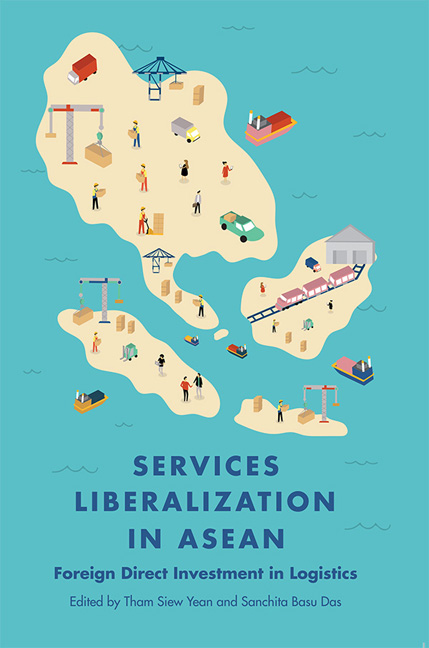Book contents
- Frontmatter
- CONTENTS
- List of Tables
- List of Figures
- Foreword
- Preface
- Acknowledgements
- Abbreviations
- About the Contributors
- 1 Introduction
- 2 Reforming Indonesia's Logistics Sector
- 3 FDI Liberalization in Malaysia's Logistics Services
- 4 Logistics Services Liberalization in the Philippines
- 5 Services Sector Liberalization in Singapore: Case of the Logistics Sector
- 6 Logistics Services Liberalization in Thailand
- 7 Services Liberalization in Vietnam: The Case of FDI in Logistics Sector
- 8 Services Liberalization: Case of Logistics in Brunei
- 9 FDI, Services Liberalization and Logistics Development in Cambodia
- 10 Services Liberalization in Lao PDR: FDI in Logistics Sector of a Land-linked Country
- 11 Facilitating FDI for the Logistics Sector in Myanmar: Agency, Incentives, and Institutions
- Index
8 - Services Liberalization: Case of Logistics in Brunei
Published online by Cambridge University Press: 04 July 2018
- Frontmatter
- CONTENTS
- List of Tables
- List of Figures
- Foreword
- Preface
- Acknowledgements
- Abbreviations
- About the Contributors
- 1 Introduction
- 2 Reforming Indonesia's Logistics Sector
- 3 FDI Liberalization in Malaysia's Logistics Services
- 4 Logistics Services Liberalization in the Philippines
- 5 Services Sector Liberalization in Singapore: Case of the Logistics Sector
- 6 Logistics Services Liberalization in Thailand
- 7 Services Liberalization in Vietnam: The Case of FDI in Logistics Sector
- 8 Services Liberalization: Case of Logistics in Brunei
- 9 FDI, Services Liberalization and Logistics Development in Cambodia
- 10 Services Liberalization in Lao PDR: FDI in Logistics Sector of a Land-linked Country
- 11 Facilitating FDI for the Logistics Sector in Myanmar: Agency, Incentives, and Institutions
- Index
Summary
Introduction
Brunei's economy is in the middle of a critical transition from an oil-rich and oil-dependent state to a diversified economy that is dynamic and sustainable. The rich natural endowment of oil resources has enabled Brunei to become one of the richest state in ASEAN and the world. According to IMF (2016a), based on Gross Domestic Product (GDP) (in PPP terms) per capita, Brunei is the fifth wealthiest state in the world and the second wealthiest in ASEAN in 2016, after Singapore which is ranked at number four in the world. The oil wealth, in turn, has enabled the country to depend primarily on oil for its revenue since there is no income nor sales tax for locals. Free education through university and subsidized housing is additionally provided for its citizens. It has also led to a dominant role of the state in terms of its control over the economy as well as employment, as an estimated 70–80 per cent of the Bruneians work for the government or government-linked institutions (Prusak 2016).
Economic diversification, although viewed in terms of a more balanced contribution of manufacturing and services, may in reality entail far more than that. It may necessitate, for example, a reconsideration of the country's fiscal budgeting and its ensuing implications on the extent of public goods provided by the state. The sharp drop in global price of oil in 2014 and after, had a detrimental impact on the state revenue, leading to a fiscal deficit of 16 per cent of its GDP for the fiscal year 2015/16 (Prusak 2016). Economic growth was also affected, with the country's annual growth falling into negative rates from 2013 to 2016. Current forecasts of future oil prices do not seem to indicate that there will be a price recovery to its peak value in 2010 (Knoema n.d.). Hence sustainability will require considering diversifying sources of fiscal revenue, tightening government expenditure and a restructuring of the privileges enjoyed by the citizens. Injecting dynamism into the economy will also require rebalancing the role of the state and the private sector in generating economic growth.
- Type
- Chapter
- Information
- Services Liberalization in ASEANForeign Direct Investment in Logistics, pp. 242 - 267Publisher: ISEAS–Yusof Ishak InstitutePrint publication year: 2017

